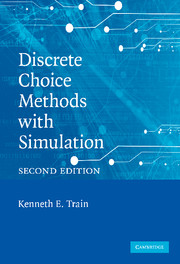13 - Endogeneity
Published online by Cambridge University Press: 05 June 2012
Summary
Overview
So far we have assumed that the explanatory variables that enter a discrete choice model are independent of the unobserved factors. In many situations, however, the explanatory variables are endogenous, that is, are correlated or otherwise not independent of the unobserved factors. Examples include the following:
Unobserved attributes of a product can affect its price.
In modeling consumers' choices among products, it might be impossible to measure all of the relevant attributes of the various products. In the case of cars, for example, the researcher can obtain information about the fuel efficiency, length, width, horsepower, weight, and many other attributes of each car that is offered by manufacturers, but attributes such as comfort, beauty of the design, smoothness of the ride, handling in curves, expected resale value, and prestige cannot be measured directly. Yet the price of the product can be expected to reflect these unobserved (i.e., unmeasured) attributes. There are two reasons why price is affected. First, insofar as the unobserved attributes are costly for the manufacturer, the price of the product can be expected to reflect these costs. Second, insofar as the unobserved attributes affect demand for the product, a price that is determined by the interaction of demand and supply can be expected to reflect these differences in demand. The end result is that price is correlated with unobserved attributes, rather than being independent as we have assumed so far in this book. […]
Information
- Type
- Chapter
- Information
- Discrete Choice Methods with Simulation , pp. 315 - 346Publisher: Cambridge University PressPrint publication year: 2009
